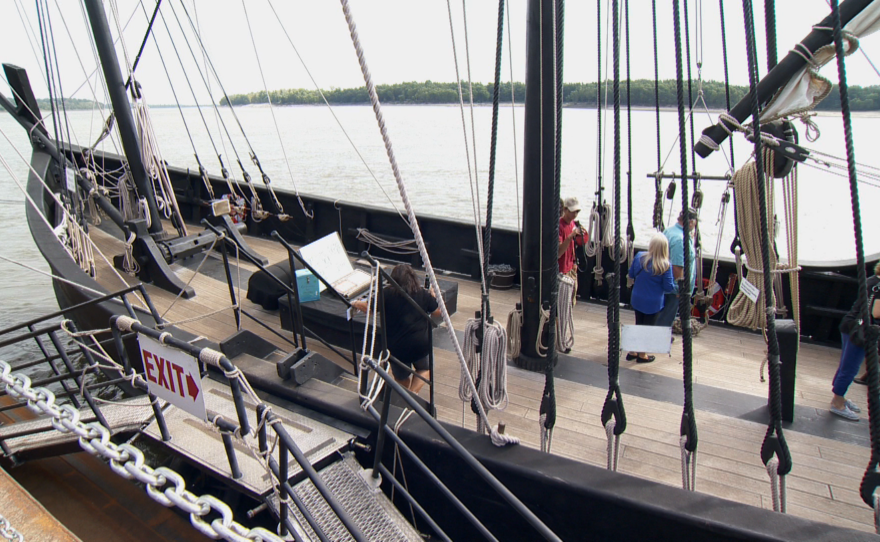More than 500 years ago, Christopher Columbus set sail in three ships looking for a faster route to Asia.
He ended up discovering the Bahamas and a new world.
Less than 30 years ago, the Columbus Foundation wanted to build replicas of all three ships.
Money and time constraints prevented them from building all three, so they decided to build the Niña in time for the 500th anniversary of Columbus’s voyage.
“They started off building the Niña, its one of the most well known caravel’s in history so they built the Niña to be as accurate as possible based on about 3 or 4 years of research and took 32 months of construction because it was done entirely by hand.”
About 12 years ago, the Pinta set sail - but builders made this ship a little bigger to accommodate the number of visitors.
Both ships were built in the same place: Brazil.
“It’s the only place in the world that people still know how to build them, the same it would have been built back in the 1400’s all the hand tools, the methods and techniques used 500 some odd years ago. Historically there Portuguese by design.”
Today they are used as floating museums.
"I was expecting it to be a little bit bigger, but no actually it's a little small"- Lyndee Horton, 3rd Grader.
“We try to travel around the country and educate the public on what life was like to be a sailor back then, what life was like on these ships while crossing the Atlantic Ocean and again on the age of discovery.”
Lyndee Horton from the Caruthersville Elementary School toured the ships with her class this week.
“We are going to learn about Christopher Columbus and how he sailed and why he sailed and how the ship kind of works.”
The students learned facts about Columbus’ different voyages.
“He got to the Bahamas, they got to Cuba, then they hit Hispaniola, which today we call Haiti in the Dominican Republic.
Facts about the ship
“That anchor weighs between 4 and 5 hundred pounds, it is very heavy, it is massive and you can not pull that up all by yourself, I don’t care how strong you think you are, I don’t care how many vegetables that you eat its not going to make a bit of difference.”
How it works
“But as this comes down there’s a good large thunk over on this side, that thunk is the break.”
Life at sea
“The captain would give the order to cut and run, so basically you’d take out your knife, you going to cut through the anchor line and leave it where it is at the bottom of the ocean. And get out of there while you still can”
Lyndee really enjoyed the opportunity to visit the floating museums.
“I think the reason that they make the boat is so you can actually feel like your going to be sailing and like just to get you to feel like your going to get ready and it helps you like turn on your brain.”
One of the things that surprised Lyndee was the size of the ships.
“I was expecting it to be a little bit bigger but no actually it’s a little small, like back there is the Queen of the Mississippi and I was expecting it to be big but no it looks like a tiny little bitty pirate ship.”
Third grade teacher Dana Constant had to do a little convincing to get her class on board.
“When I first started talking about bring them here they weren’t to interested, but after the videos and the discovery education experiences they wanted to come and were excited about it.”
Even Mrs. Constant learned something new on this field trip.
“I didn’t know that just little children under 5 feet tall went down below to take care of the animals and dipping out the overspill or what ever called it, I didn’t know that just children did that.”
It wasn’t just school students that were excited to see the ships.
Joyce Brewer also has a sailboat, only hers is smaller.
She enjoys the chance to see other sail boats.
“Its very dynamic anytime you can get history and bring it alive, it has a bearing on our life today, to help us think about why were here, how we got here, what it would have been like if somebody else wouldn’t have come across the ocean its fantastic.”
When these ships were built their life span was only 20 years or less, but with modern technology and up kept the Niña is well past that.
“Our Niña here will be turning 26 in December and she’s still going pretty strong.”
After stopping at hundreds of ports, the miles have been adding as well.
“The captains will have a better estimate than I do, hundreds of thousands on the Niña, I’ve heard between 400 and 500 hundred thousand at this point, which is phenomenal for a ship of this type.”
The Pinta and Niña are docked in Cape Girardeau until Monday October 9th.















